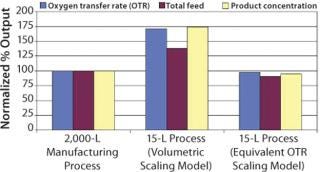Tuning Oxygen Transfer in Small-Scale Fermentors to Mimic Manufacturing Productivity: A Case StudyTuning Oxygen Transfer in Small-Scale Fermentors to Mimic Manufacturing Productivity: A Case Study

Figure 1:
An appropriate fermentation scale-down model is critical to allow comparison of lab scale studies to the manufacturing case. Modeling of fermentors increases confidence that a fermentation process is scalable within the confines of available equipment and that the data acquired are an accurate representation of production fermentations. Modeling fermentation oxygen transfer between development scales of 1–100 L and production scales of 1,000–10,000 L+ has been extensively studied, and there are numerous approaches including P/V, KLa, and OUR models. In the current analysis, key parameters were varied in small-scale fermentors until the key output parameters matched the manufacturing case. These modifications led to the development of a functional small-scale fermentation model that is highly sensitive to oxygen transfer and can mimic variations seen at scale. Application of this model to other programs has great benefit and increases Diosynth’s confidence in scale-up and scale-down between the 15-L process development and 2,000-L manufacturing scales.
The Case Study
The fermentation process used to support the functional oxygen transfer model was an Escherichia coli fed-batch process with DO-stat feed-based control loop. DO control loops tied around culture feed can be highly sensitive to changes in oxygen transfer that may arise upon scale-up or scale-down or due to process modifications. Upon implementing a process change, the need arose to refine the small-scale model for the 1,500 L working-volume fermentation. During model development, initial attempts to run the process at 8 L working volume using a volumetric scaling approach led to product concentrations that were >60% above the manufacturing average with parallel increases in glucose use and oxygen uptake rate (OUR). The unusual goal of lowering product concentration was achieved by reducing airflow until product titer, glucose use, and OUR agreed with manufacturing trends (Figures 1 and 2). Subsequent analysis using OUR data resulted in OTR and kLa values that can be used for future scale-down and scale-up studies.

Figure 1: ()

Figure 2: ()
Applications of Oxygen Transfer Modeling to Fermentation Processes
Scale-Down: Commercial manufacturing processes require small-scale support for process optimization, evaluation of necessary changes to the fermentation processes (e.g. raw material exchange), or evaluating variation in fermentation productivity/behavior. Using laboratory-scale fermentors can improve response time to investigations and reduce cost but require modeling to accurately assess the production scale process. Scale-down models also aid in transferring client large-scale processes into Diosynth development laboratories, are critical for process characterization and range finding, and are considered an FDA requirement.
Scale-Up: The Diosynth process development group is responsible for transferring client fermentation processes into the facility for evaluation and scoped modifications to improve productivity, robustness, and scalability. Typically, small-scale fermentors are capable of higher productivity due to increased oxygen transfer and more efficient mixing mechanics. Scale modeling is used to simulate fermentation conditions at the expected production scale to accurately predict process outputs that impact fermentation, recovery, downstream processing, and also utility requirements.
You May Also Like






